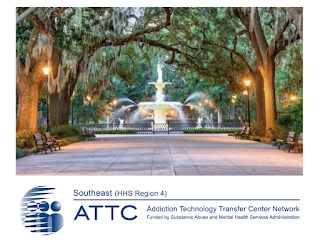Dawn Tyus, LPC, MAC, NCC
Director, Southeast ATTC
Celene Craig, MPH, MS
Over the past decade, there has been an emphasis on addressing the acute alcohol and drug addiction crisis in the United States. In 2016, more than 63,000 drug overdose deaths occurred in the U.S., a 21.5% increase from 2015. As of 2018, 20.1 million Americans age 12 or older have a substance use disorder (SUD) involving alcohol or illicit drugs. Within this estimation, 2.1 million people had an opioid use disorder (OUD), according to Substance Abuse and Mental Health Services Administration. Though it may seem that life-saving medicines and psychological interventions are important biological aspects in helping a person with a SUD, treating the inner, spiritual side of healing through recovery is also a central part of the continuum of addiction healthcare.
From 2002 to 2018, recognition has increased for evidence-based studies that focus on the importance of patient spirituality in treatment and healing of SUDs due to a mandate by the Joint Commission on Accreditation and Healthcare for the administration of a spiritual assessment by healthcare providers for patients and their families. Evidence-based studies have demonstrated the positive impact of faith on health and wellbeing — such as leading to lower levels of substance abuse and reducing the likelihood of using various drugs — in the course of a lifetime. These findings make including a body-mind-spirit integrated model of intervention essential, and indispensable in substance abuse prevention and recovery. Addiction specialists have found that 73% of addiction treatment programs in the United States include a spirituality-based element and faith-based volunteer support groups contribute up to $316.6 billion in savings to the economy every year. According to an overview of the available evidence-based studies on the effectiveness of faith-based substance use support programs, conducted by Brian and Melissa Grim in 2019, 84% of the studies show that faith is a positive factor in addiction prevention or recovery and a risk in less than 2% of the studies reviewed.
Faith-based organizations fill the gap where federal and state agencies are logistically unable to effectively and comprehensively confront the substance use epidemic. It shows that these organizations are able to reach beyond the person with a SUD and wrap support around their family and community.
“The value of faith-oriented approaches to substance abuse prevention and recovery is indisputable and the current decline in religious affiliation in the USA is not only a concern for religious organizations but constitutes a national health concern,” Grim said.
For the past 17 years, the Southeast Addiction Technology Center’s (SATTC) vision has been to transfer technology to faith leaders; increase the SUD workforce capacity within faith settings; and increase assessment, referral and engagement to care. SATTC has collaborated with communities of faith through the facilitation of conferences, learning academies, listening sessions, webinars and SUD workshops. It has been our mission to:
- Dialogue and strengthen the substance use disorder knowledge for people working in communities of faith.
- Teach communities of faith how to be catalyst for change in their communities.
- Teach faith communities how to spark the conversation that “recovery is real, and treatment does work”
- Bridge the gap between faith systems and community providers.
- Empower faith communities to reduce the stigma associated with substance use disorders.
- Provide measurable results for our target population.
- Build capacity associated with substance use disorders that will aid in creating powerful and sustainable recovery ministries.
- Promote access to services and resources that will empower communities and their partners, to create a welcoming and supportive environment.
We are committed and eager to bridge the gap between community providers and communities of faith to dispel the stigma around addiction and increase the knowledge capacity of faith leaders in the Southeast region. Through our intensive technical assistance program-development process, learning communities and trainings, we are able to equip faith leaders with the knowledge and skills to be change agents in their communities and help all people suffering with a substance use disorder.
Grim, B.J. & Grim, M.E. J Relig Health (2019). https://doi.org/10.1007/s10943-019-00876-w https://link.springer.com/article/10.1007/s10943-019-00876-w#citeas



